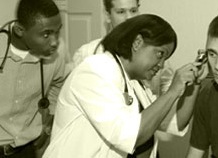Social Mission of Med Schools
 by Danielle Ofri
by Danielle Ofri
CNN
What exactly is the mission of a medical school? Is it to train the best and smartest doctors? Is to tend to our nation’s health? Is it to further medical knowledge?
Go to the website of just about any medical school and you will see roughly the same “three-pillars†message from the dean, or the chairman, or the residency program director. Every medical school stresses their commitment to the triumvirate of education, research, and patient-care.
An interesting analysis of the “social mission†of medical schools comes in . The researchers created their own three-pronged metric that measures three areas that are currently lagging in medicine: physicians working in primary care, physicians working in medically underserved regions, and physicians from minority groups.
The researchers looked at 60,000 medical students who graduated between 1999-2001 and calculated the percentage of who fell into these three categories. Essentially they added these values together to create a “social mission score.â€
They ranked all 141 American medical schools, and though there wasn’t space to list all 141 in the article, they did print the top 20 and the bottom 20. Having been a cut-throat medical student once myself, I immediately scanned the scores. I was crushed to find my institution nestled in the bottom 20 (oh, failure!), though we were in excellent company.
Community-based medical schools and public medical schools were prominent in the top 20. The bottom 20 was a whose-who of big-name, big-research institutions (the ones that usually topped the US News & World Report Hospital rankings).
These results were not surprising, but it still stung to find my alma mater prominently posted at the bottom of the list. One of the reasons I’d chosen my medical school—and stayed for residency training, and have continued on as a faculty member—is that the bulk of the medical training is done in an inner-city hospital.
The faculty who work full-time in primary care at our city hospital like to think that we act as role models to our students, that “walking the walk†speaks loudly enough. But apparently not. Only a quarter of our students chose to enter primary care (general internal medicine, family medicine, and pediatrics) in the years covered by the study.
The accompanying editorial pointed out that there are many factors that medical schools cannot influence. Medical schools can do little, for example, about the fact that primary care medicine is packed with aggravation, with lower financial rewards. For many medical students, taking the ROAD—radiology, ophthalmology, anesthesiology, dermatology—is mighty appealing. Excellent pay, less hassle, more control.
And of course there are some specialty fields that actually do provide primary medical care, particularly OB-GYN, which weren’t included in the study’s definition of primary care.
Despite its limitations, though, the study is a wake-up call to medical educators, medical students, practicing physicians and society in general. While this “social mission†isn’t the only mission of medical schools, it is an important one. Of course we want high-end research to continue in medical schools. Of course we want cutting-edge specialty care to proliferate. But medicine is unique in that it possesses a social mission and it’s clear that as a profession we are falling behind in this area.
The good news is that most medical students are cognizant of this. When I work with students it’s clear that the social mission of medicine has meaning for them. It’s more than just lip service or application-essay material. I truly think that the majority of medical students come to this field for the right reasons. The challenge for medical educators is keep that flame alive.
We certainly need to emphasize primary care, since our nation desperately needs legions of more primary-care doctors. There is no need to denigrate specialists, however, because they are also critical to good medical care. But we can emphasize the need for specialists to contribute to the social mission. For those who are not working in underserved areas (which is the majority), medical schools can stress the ethical obligation to providing some care pro bono, or to the uninsured and underinsured patients who have the hardest time getting specialty care.
Increasing the diversity of doctors may be the trickiest aspect of the three pillars of the social mission, since there are economic and academic issues entwined that have roots far deeper than the medical school admissions process. However, medical schools can make themselves more hospitable places to minorities. The progress of women in medicine offers both lessons and pitfalls (vastly more women in medicine now, but most in the low pay/prestige fields, and few in upper-echelon positions of power.)
There are many who may quibble about this study, who may say that the “social mission†of medicine is a professional state of mind, not a calculus of minority physicians who do primary care in rural areas. And there is truth to that: many white, male, Ivy-League cardiologists are extremely ethical, humanitarian, and generous.
But there is something to be said for measures that go against what is most expedient. The truth is, if medicine continues on its current track, it will become harder and harder to find a good primary-care doctor, even if you are a cardiologist yourself. Â (from CNN)
